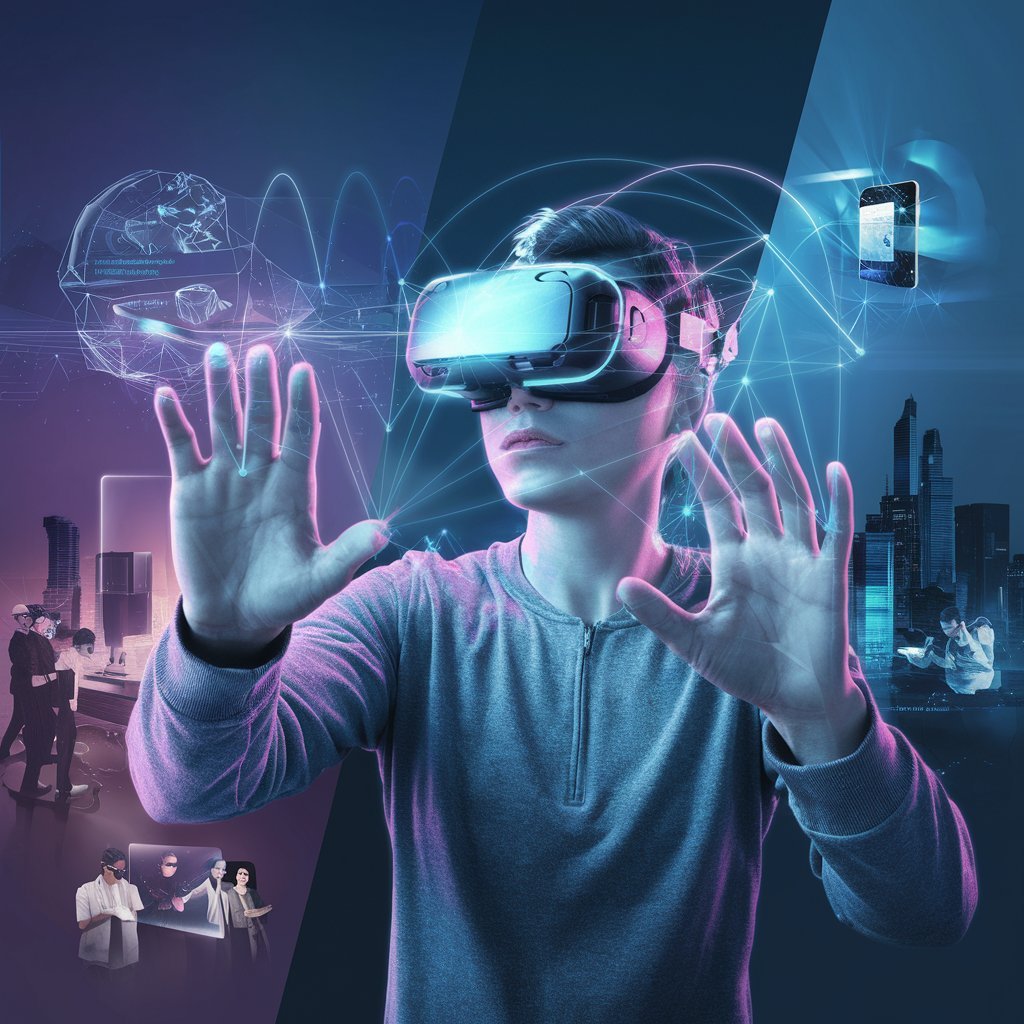In an era where the lines between physical and digital realities are increasingly blurred, immersive technologies are at the forefront of a revolutionary shift in how we interact with information, entertainment, and each other. From virtual reality (VR) to augmented reality (AR) and mixed reality (MR), both businesses and individuals are driving innovations that promise to reshape our world. This article explores the cutting-edge ways in which companies and consumers are embracing and advancing immersive technologies, creating experiences that were once the realm of science fiction.
The Imperative of Immersive Technology for Businesses
Forward-thinking companies are realizing that immersive technology is not just about creating novel experiences – it’s about reimagining entire business processes, enhancing productivity, and creating new avenues for customer engagement. By implementing VR, AR, and MR solutions, businesses are finding innovative ways to train employees, design products, and offer unique customer experiences.
One striking example is the adoption of VR in employee training. These immersive experiences are revolutionizing how companies prepare their workforce, offering safe, repeatable, and highly engaging simulations for everything from complex surgical procedures to hazardous emergency responses. Companies embracing VR training are seeing improved learning outcomes, reduced costs, and enhanced safety in high-stakes environments.
Case Study: Walmart’s VR Employee Training
Walmart’s implementation of VR training exemplifies the transformative power of immersive technology in corporate learning. By using VR headsets to simulate Black Friday scenarios and other challenging customer service situations, Walmart has significantly improved employee preparedness and confidence. This showcases how corporate innovation in immersive technology can have profound impacts on operational efficiency and customer satisfaction.
The Rise of Augmented Reality in Retail and E-commerce
Another area where businesses are making significant strides is in the implementation of AR for retail and e-commerce. By allowing customers to virtually “try on” products or visualize items in their own space before purchasing, AR is bridging the gap between online and in-store shopping experiences. This technology is not only enhancing customer satisfaction but also reducing return rates and increasing sales conversions.
Individuals as Catalysts for Immersive Technology Advancement
While businesses play a crucial role in driving immersive technology innovation, individual adoption and creativity collectively shape the direction and impact of these advancements. From content creators developing immersive art installations to early adopters providing valuable feedback on new VR applications, each person can contribute to the evolution of immersive technologies.
The growing trend of “social VR” exemplifies how individuals are shaping the future of immersive experiences. By participating in virtual worlds, attending VR concerts, or creating custom avatars for social interactions, people are pushing the boundaries of what’s possible in digital social spaces and influencing the development of more sophisticated, engaging virtual environments.
The Impact of Consumer VR Gaming
One of the most visible ways individuals are driving immersive technology innovation is through the adoption and engagement with VR gaming. As more people integrate VR gaming systems into their homes, it’s creating a demand for more advanced, immersive, and physically interactive gaming experiences. This consumer-driven shift is accelerating advancements in haptic feedback technology, motion tracking, and realistic graphics rendering.
Augmented Reality in Everyday Life
The widespread adoption of AR applications on smartphones represents another area where individual users are significantly impacting immersive technology development. From AR navigation apps to social media filters, the integration of AR into daily life is pushing developers and companies to create more seamless, useful, and creative augmented experiences. This grassroots-level engagement is driving the miniaturization and improvement of AR hardware, paving the way for future wearable AR devices.
Collaborative Innovation: The Key to Immersive Technology Advancement
The most groundbreaking immersive technology solutions often emerge when businesses, individuals, and academic institutions work together. Open standards and collaborative platforms have become hotbeds for innovation, allowing for the collective effort of developers worldwide to create more interoperable and advanced immersive experiences.
Success Stories in Cross-Industry Collaboration
The development of WebXR, a set of standards for creating VR and AR experiences that work across different devices and platforms, demonstrates the power of collaborative innovation. This initiative, involving tech companies, individual developers, and standards organizations, is making immersive experiences more accessible and consistent across the web, opening up new possibilities for businesses and creators alike.
The Role of Hackathons and Jams in Fostering Immersive Innovation
Immersive technology hackathons and game jams have emerged as powerful tools for spurring rapid innovation in the field. These events bring together diverse groups of developers, designers, and creatives to build novel VR and AR applications in a short time frame. Companies often sponsor these events, benefiting from the fresh ideas and innovative solutions that emerge, while participants get the opportunity to push the boundaries of immersive technology and network with industry leaders.
The Role of Emerging Technologies in Advancing Immersive Experiences
Advancements in related technologies are playing a crucial role in enhancing immersive experiences. From 5G networks promising to enable more responsive and detailed virtual worlds to artificial intelligence improving real-time language translation in social VR spaces, cutting-edge technologies are pushing the boundaries of what’s possible in immersive environments.
Haptic Technology: Bringing Touch to Virtual Worlds
Haptic technology is revolutionizing how we interact with virtual and augmented environments. By simulating the sense of touch, haptic devices are adding a new dimension to immersive experiences, enhancing realism in VR training simulations, adding tactile feedback to AR interfaces, and opening up new possibilities for remote collaboration and teleoperations.
Brain-Computer Interfaces and the Future of Immersion
While still in the early stages, research into brain-computer interfaces (BCIs) holds the promise of creating truly immersive experiences that can be controlled by thought alone. As this technology develops, it could revolutionize how we interact with virtual and augmented realities, potentially allowing for more intuitive control, enhanced accessibility for individuals with physical disabilities, and even the direct transmission of sensory experiences.
The Emotional Impact of Immersive Technology
Engaging with immersive technology isn’t just about experiencing new digital worlds – it’s an emotionally charged journey that can profoundly impact our perceptions, empathy, and connections with others. There’s a sense of wonder and possibility in knowing that through VR and AR, we can experience perspectives and realities far beyond our physical limitations.
As we witness the applications of immersive technology – from therapeutic uses helping individuals overcome phobias to virtual museums preserving cultural heritage – we’re reminded of technology’s potential to expand human experience and understanding.
Building Empathy Through Immersive Experiences
Immersive technologies have shown a unique ability to foster empathy by allowing users to “walk in someone else’s shoes.” VR experiences that simulate the challenges faced by marginalized groups or visualize the effects of climate change can create powerful emotional connections to issues, potentially driving greater awareness and action.
The Psychological Benefits of Virtual Escapism
Research has shown that engaging with immersive technologies can have significant positive effects on mental health and well-being. Virtual reality experiences have been used successfully in treating anxiety disorders, PTSD, and chronic pain. The ability to escape into calming virtual environments or to face fears in a controlled, virtual setting can provide therapeutic benefits and stress relief in our increasingly complex world.
Conclusion: A Call to Action
The path to a future enhanced by immersive technologies is paved with innovation, collaboration, and personal engagement. Whether you’re a business leader exploring VR training solutions, a developer creating AR applications, or an individual eager to experience new virtual worlds, remember that every interaction with immersive technology is an opportunity to shape its development and impact.
By embracing creativity, continuously pushing the boundaries of what’s possible, and considering the ethical implications of our innovations, we can all play a part in creating an immersive technology future that enhances human potential and addresses global challenges. The possibilities before us are vast, from revolutionizing education and healthcare to creating new forms of art and entertainment.
The time for thoughtful and purposeful immersive technology innovation is now – let’s dive into this future together. By combining the resources and vision of businesses with the creativity and enthusiasm of individuals, we can create a wave of positive change that reverberates across society. Our immersive future depends on the choices we make today. Let’s choose innovation, responsibility, and collective action to build a world where immersive technologies serve as a force for good, expanding our horizons, fostering empathy, and creating new realms of human experience.





